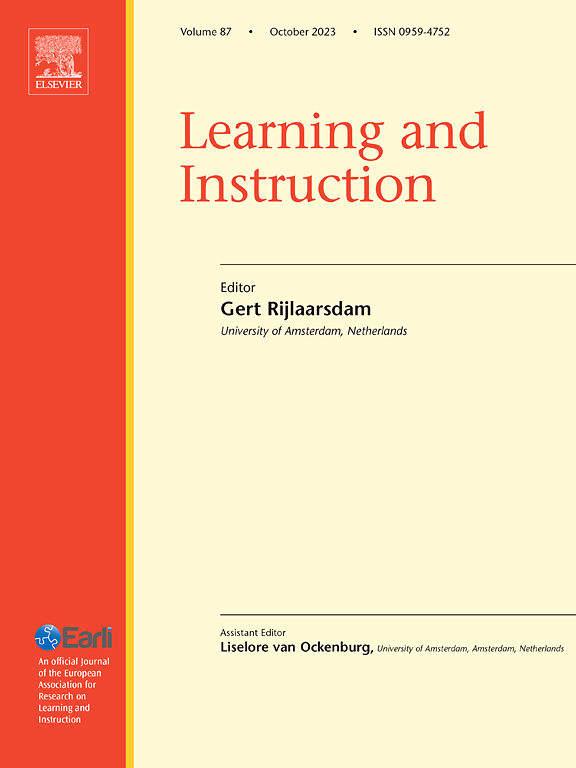探究高质量谈话讨论中的年级水平和文本类型效应:基于ai的高年级小学生高水平理解语篇分析
IF 4.9
1区 教育学
Q1 EDUCATION & EDUCATIONAL RESEARCH
引用次数: 0
摘要
小学高年级的学生在阅读时必须从基本理解向高级理解(HLC)发展。小组,基于文本的讨论为学生提供了发展批判性分析思维和论证的机会,支持他们的HLC。目的:我们探讨了小学高年级学生在一学年进行小组讨论时,在何种程度上证明了HLC指标的增长,同时也检查了年级水平和文本类型的差异。样本参与者包括四年级(n = 64)和五年级(n = 69)的学生。方法采用单组纵向设计,将“质量谈话”嵌入到6个小学高年级的语言艺术课程中。视频记录的讨论(n = 371)被转录。我们采用了人工智能(AI)驱动的编码方法来识别讨论记录中的HLC指标。结果小学高年级学生群体的HLC指标在整个学年平均有所增长。平均而言,由五年级学生组成的小组比四年级学生有更高的详细解释率,并且平均而言,所有学生在基于混合体裁和说明文体裁的讨论中产生更高的详细解释率。结论:本研究的发现有助于越来越多的关于小学高年级年级水平差异的文献,以及文本类型对小组讨论中出现的HLC指标的影响。值得注意的是,该研究还采用了一种新颖的、人工智能驱动的编码方法来进行话语分析,这值得在未来的研究中进一步探索。本文章由计算机程序翻译,如有差异,请以英文原文为准。
Investigating grade-level and text genre effects in Quality Talk discussions: An AI-powered discourse analysis of upper primary students’ high-level comprehension
Background
Students in upper primary grades must move beyond basic comprehension toward high-level comprehension (HLC) of text as they read. Small-group, text-based discussions provide opportunities for students to develop their critical analytic thinking and argumentation, supporting their HLC.
Aims
We explored the extent to which groups of upper primary students evidenced growth on indicators of HLC as they engaged in small-group, text-based discussions over a school year, while also examining grade-level and text genre differences.
Sample
Participants included fourth- (n = 64) and fifth-grade (n = 69) students.
Methods
We employed a single-group, longitudinal design, whereby Quality Talk was embedded into the language arts curriculum of six upper elementary classrooms. Video-recorded discussions (n = 371) were transcribed. We employed an artificial intelligence (AI) powered coding approach to identify indicators of HLC in the discussion transcripts.
Results
Groups of upper primary students, on average, evidenced growth in the rates of HLC indicators over the school year. Groups composed of fifth-grade students, on average, had higher elaborated explanation rates than fourth-grade students, and all students, on average, produced a higher rate of elaborated explanations for discussions based on mixed genre versus expository genre texts.
Conclusions
Findings from this study contribute to a growing body of literature about grade-level differences in upper primary grades, as well as the influence of text genre on indicators of HLC present within small-group discussions. Notably, the study also employed a novel, AI-powered coding approach for our discourse analysis, which warrants further exploration in future research.
求助全文
通过发布文献求助,成功后即可免费获取论文全文。
去求助
来源期刊

Learning and Instruction
Multiple-
CiteScore
11.30
自引率
4.80%
发文量
109
期刊介绍:
As an international, multi-disciplinary, peer-refereed journal, Learning and Instruction provides a platform for the publication of the most advanced scientific research in the areas of learning, development, instruction and teaching. The journal welcomes original empirical investigations. The papers may represent a variety of theoretical perspectives and different methodological approaches. They may refer to any age level, from infants to adults and to a diversity of learning and instructional settings, from laboratory experiments to field studies. The major criteria in the review and the selection process concern the significance of the contribution to the area of learning and instruction, and the rigor of the study.
 求助内容:
求助内容: 应助结果提醒方式:
应助结果提醒方式:


